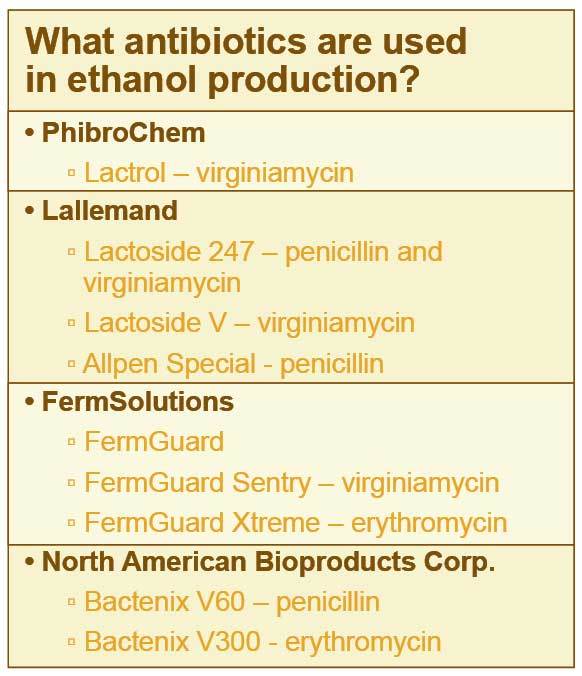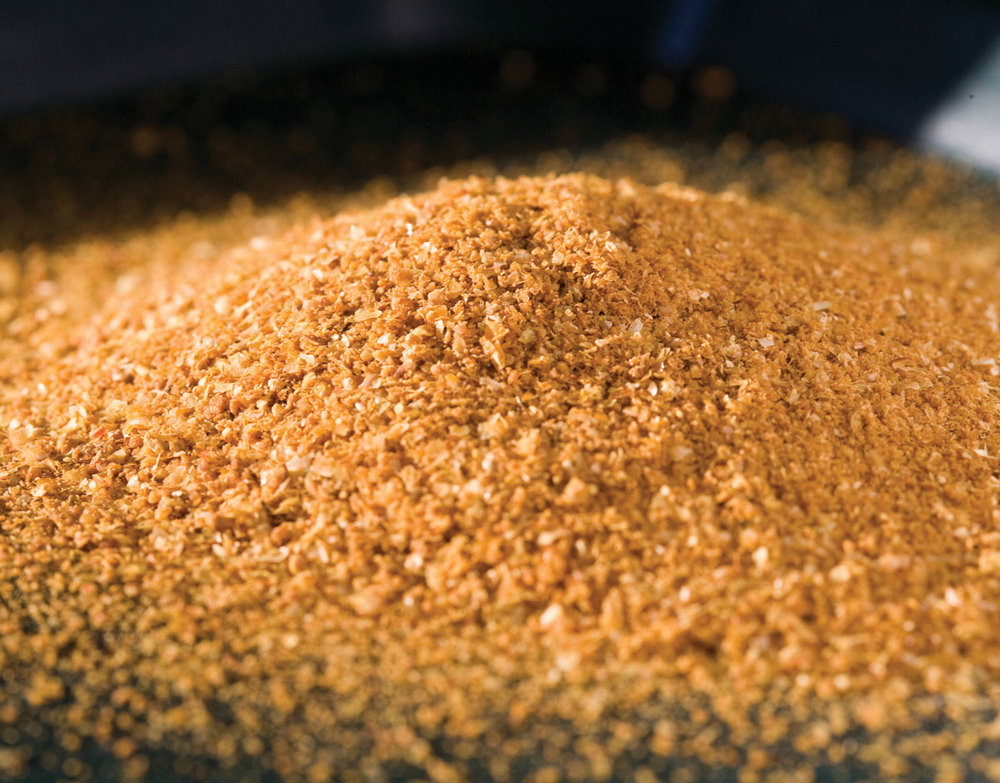Testing for Traces



July 10, 2012
BY Holly Jessen
Are the antibiotic residues found in distillers grains biologically active? And, if they are, could antibiotic use in distillers grains production contribute to antibiotic resistance in animals? While the answer may vary depending on the source, one thing researchers agree on is that more study is needed.
The University of Minnesota spent one year investigating whether antibiotic residues survive the ethanol production process—concluding that those residues are not biologically active, says Gerald Shurson, a swine nutrition and management professor at the U of M. Shurson is one of six researchers from the Department of Animal Sciences, the U of M Extension Service and the Department of Food Science and Nutrition, who worked on the study. Final data collection wrapped up this spring and the researchers plan to publish the results in the Journal of Animal Science, possibly by the end of the year, he says. Funding came from the Minnesota Corn Research and Promotion Council.
Later, at the International Fuel Ethanol Workshop & Expo, held June 4-7 in Minneapolis, the outcome of two additional studies were presented. Kenneth Bischoff, a research microbiologist with the USDA’s Agricultural Research Service (ARS), revealed something different—that the antibiotic virginianmycin did remain biologically active through the ethanol production process. A second research project examined the same distillers grains produced in the first USDA study and determined that feeding cattle distillers grains that contained antibiotic residues had minimal or no influence on antimicrobial susceptibility of fecal bacteria or dissemination of resistance genes. The results of that study were presented by Tom Edrington, a research animal scientist with the food science research unit of USDA ARS.
In Minnesota
The U of M study follows up on unpublished U.S. Food and Drug Administration studies, which found antibiotic residues do remain in distillers grains through the ethanol production process. Using the same procedures FDA used, the Minnesota researchers came to the same conclusion. There were tiny amounts of antibiotic residues in the distillers grains, but not enough to exceed what the FDA has set as limits in animal feed. “Relative to approval levels of our FDA, they are minuscule amounts,” Shurson says.
What they did differently, he explains, is take it a step further to investigate whether distillers grains samples showed any bacterial inhibition when two bacteria—E. coli and listeria monocytogenes—were introduced. Samples of both wet distillers grains and DDGS were collected and analyzed quarterly for one year. Every sample of distillers grains analyzed contained residues of antibiotics. The concentrations were very low, however, when compared to the FDA-approved feed levels. In addition, out of 159 samples, only one showed inhibition of E. coli bacteria and none with listeria monocytogenes. In searching for biologically active residues, the researchers put distillers grains extracts in bacteria-seeded petri dishes. Because the majority of the extracts didn’t show any signs of bacterial inhibition, researchers concluded that the antibiotic residues were not biologically active. Only one distillers grains extract killed the bacteria in the petri dish. That sample resisted the growth of E. coli and contained 0.015 ppm virginiamycin and 0.014 ppm erythromycin. “Even though we find small amounts of antibiotics in these distillers, there isn’t any biological activity,” Shurson says.
Based on the literature from other research studies, the environmental conditions in an ethanol plant inactivate antibiotics in the production process. Penicillin is very sensitive to pH and is inactivated fairly quickly as the pH drops to the 3.5 to 4 range, he says. Virginiamycin, on the other hand, is very heat sensitive, and is destroyed in temperatures above 93 degrees. Distillers grains dryers operate at temperatures from 93 to 232 degrees. Tylosin is inactivated with increased temperature levels and is the most stable at pH 3.5 and 9. Although the inactivation of erythromycin is less well-documented, Shurson said there is likely some inactivation of that antibiotic as well.
Advertisement
The most commonly used antibiotic is virginiamycin. Virginiamycin and penicillin, also used by the industry, are listed as generally recognized as safe (GRAS.) The U of M study identified residues of both virginiamycin and penicillin, as well as erythromycin. The puzzlers were tetracycline and tylosin, particularly the latter. “We’re not clear at all where this would be coming from,” Shurson says. “We know the least about this particular antibiotic.”
The results of the U of M study is positive news for the ethanol industry, the majority of which still uses antibiotics to control bacterial infection in the production process, Shurson says. “The fate of using these antibiotics in animal production has not yet been decided by FDA, which in my opinion has a much more significant bearing on the issue than the level of antibiotics used in ethanol production,” he said. Not everyone agrees, however. “The use of antibiotics in animal feeds has received increased scrutiny and attention from many groups, and thus, continues to be one of the most controversial issues facing agriculture today,” Shurson says.
In May, before U of M researchers had finished compiling the results of the fourth and final survey of distillers grains samples, an 11-page report from the Institute for Agriculture and Trade Policy referenced its preliminary findings. Julia Olmstead, author of “Bugs in the System: How the FDA fails to Regulate Antibiotics in Ethanol Production,” focused in on the one sample of distillers grains that exhibited inhibition of E. coli and called for immediate action. For one thing, Olmstead wants the FDA to ban sales of unapproved antibiotics to the ethanol industry and recommended that the ethanol industry voluntarily stop using antibiotics. The USDA, U.S. DOE and other agencies should provide technical assistance and potential financial support to the industry to help with a quick transition away from antibiotics, she said in the report. As a result, quite a few conflicting articles are floating around the Internet, some referencing the conclusions of the U of M study, some using Olmstead’s report as the only source.
Complementary Studies
In contrast, the USDA study that concluded there were biologically active antibiotics in distillers grains focused on virginiamycin. In cooperation with the National Corn-to-Ethanol Research Center, the USDA ran three fermentors: a control with no antibiotics; one with 2 ppm virginiamycin, the recommended dosage for ethanol production, and one fermentor containing 20 ppm virginiamycin. “This is not to suggest that an ethanol plant would use this type of dosage,” Bischoff said during his FEW presentation.
Samples were taken during all stages of ethanol production. The goal, he said, was to understand what affect the various processes, such as distillation, evaporation and drying have on the antibiotic residue level.The conclusion was that conditions during the ethanol production process were not sufficient to deactivate virginiamycin in distillers grains. In the samples taken from the fermentors that were dosed with only 2 ppm antibiotics, only the dried distillers grains with solubles contained antibacterial (or biological) activity. Presumably, Bischoff said, the activity was below detection at the other stages. For the fermentors dosed with 20 ppm, however, there was antibacterial activity in all the samples, starting with fermentation and moving through all the stages, including whole stillage, thin stillage, wetcake, syrup and dried distillers grains with soluables. Looking at the data on a dry-weight basis, a steady decrease in antibacterial activity was observed from the beginning to the end of the process. Virginiamycin content also varied in samples taken from the same stage of the process, but at different times, Bischoff noted.
Advertisement
More study is needed on the topic. First, more antibiotics need to be evaluated and there’s a need to increase the sensitivity of analytical method and bioassay, he said. Subsequent studies should look at the effect of varying operating parameters, such as process temperature, to increase the rate of antibiotic deactivation.
The results were concerning, Bischoff said. Viewing the data side-by-side with the results of a follow-up investigation, however, illustrates how important it is not to stop with just one study. Taking it to the next step, a second group of researchers fed cattle the distillers grains containing antibacterial residues and examined whether antibiotic residues in distillers grains would have any influence on antimicrobial susceptibility of fecal microflora or the dissemination of resistance genes. In the end, none of the findings were of concern. “Overall, I think it’s good news,” Edrington said during his presentation at FEW, which was on the same panel as Bischoff’s presentation.
In fact, the data showed that antibacterial resistance is already out there as the cattle were already showing antibacterial resistance on day zero of the study. “We can take cattle at any stage in the process and we can find resistance to bacteria,” he said. In some cases, the control group of cattle fed distillers grains produced with no antibiotics actually showed more antibacterial resistance, and antibiotic resistance tended to decrease over time in the animals fed distillers grains containing antibiotic residues.
The distillers grains used in the second study were produced at NCERC during experimentation with different levels of antibiotic use for Bischoff’s research. Cattle were separated into groups that were fed distillers grains produced using no virginiamycin, 2 ppm virginiamycin or 20 ppm virginiamycin. Another control group was fed distillers grains containing 22.5 grams per ton of a virginiamycin drug intended to be mixed into animal feed. The experiment started before the results of the first USDA study were compiled, Edrington clarified, and the researchers wanted to be certain at least one group of cattle was indeed fed virginiamycin. As it turned out, there was antimicrobial activity in the distillers grains produced with the antibiotic virginiamycin but the researchers wanted to make sure so as not to replicate other studies on this topic that used distillers grains that it was unknown if they actually contained antibiotic residues. “You have to be careful with a study,” he said. “Is it really a cause and effect relationship?”
Like the other researchers, Edrington also talked about the need for more study. This particular experiment was for 49 days and he’d like to see another study do a feeding trial for the more typical 150-day period. In this case, the study was cut shorter due to labor costs and the fact that the cattle were on concrete and typically get tender feet at about that time.
Author: Holly Jessen
Features Editor of Ethanol Producer Magazine
(701) 738-4946
hjessen@bbiinternational.com
Upcoming Events





